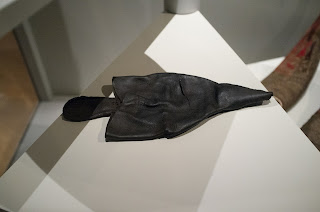On this project, I keep thinking "ah! Now as soon as I do this one thing, I'll be ready to start for realsies." And then I find six more things to sort under that one thing. This is becoming uncomfortably like my day job.
 |
For some reason, the cotton
fibers stuck immediately to the
green linen, mostly ignoring
the white. Not important,
but interesting. |
At the start of this past week, I had my new iron, I had my cotton tow (also my spine and my Orange Crush), and I figured we were rollin'. I cut out two more 10" pieces of the linen and lining, and started pulling cotton out of the Giant Cotton Blob. I did my best to floof it out (and can I just tell you, I now have a much better understanding of why it's called cotton candy) and then placed it on my swatch, sort of pushing and squidging it to make it look fairly evenly distributed. It still had some clumps and valleys, as you see, but I didn't think that would be particularly significant. (Spoilers: I was so very wrong.) I knew I would need to baste in some fashion, but thought the chief worry was that the cotton would blorp out the sides of the swatch (spoilers: I was so very wrong, at least about that being the chief worry), so I basted a half-inch around the outside, making a kind of pillow-like entity. At this point, I paused to weigh the piece, and went back and weighed the one I did with cotton batting[1]--there is .25 oz difference, for the record, which doesn't seem like much but is about a baseball-sized chunk of unfloofed raw cotton[2]. So it wasn't going to be the best comparison, but this would turn out to be the least of my problems.
 |
It's a nice wee pillow. The
cats thought so too. |
I took my quilting between in hand, threaded with some heavy linen thread I had hanging around, and started in. Within three stitches I knew this was not going to work; the linen thread's way too heavy and coarse for this work. Ctrl-Z! The Black Prince's jupon was quilted in silk thread, so OK. I dug up some silk twist, threaded that up, and started in. This was going a little bit better, but I wasn't getting anything near the fineness of stitch I was looking for; Saint Janet doesn't mention the stitches-per-inch in her article, but it looks pretty fine on the photos, and modern quilters advise 6 for newbies, 10 for experts. I was getting three. And even those were pretty questionable; it isn't just the thickness of the padding to get through, but every time I hit a clump in the cotton, the needle just wasn't going through. I tried finer needles, I tried my medieval replica needle (IT BENT. fjdkalfjdaldfj); nothing was improving the situation.
At this point I started whining on the Internets, as one does, and received counsel that instead of quilting by running stitch, I would be better served by stab stitch[3]. So I gave that a whirl, only to find, well, let's let the photos speak for themselves:
 |
Front side: uneven but at
least straight lines |
 |
| Back side: WAT |
Because, see, there's nothing holding the top linen layer and the bottom linen layer in alignment with each other; the more so since there is additional play as a result of the padding; so they are migrating all over the place. And lo, the light came on of OH THIS IS WHY THEY USED A FRAME IN PERIOD.
Those medieval guys, ya know. Not stupid. Not stupid at all.
I took further counsel with Our Panel Of Experts and found they're both using the same PVC quilting frame for this purpose, and it breaks down tidily enough that it won't be an undue strain on the limited household Lebensraum, AND I think I can also use it in future for silk-painting banners; so this weekend I went out and got me one as well. As well, I am kindly being delivered a bow this afternoon to try and bow the cotton, so hopefully I shall also have homogenous padding available by the end of the day. I just have to think through how best to rig the swatch; probably will have to lace it in like you would for an embroidery piece. (Another thing I've never actually done! Yay!)
[1] yes, the smart thing would have been to weigh just the stuffings, but that would have required me to have thought of it before I quilted the first piece.
[2] Based on our kitchen digital scale, which only measures in .25oz increments in the first place, so it's not the best/most accurate measure for this purpose. But there's a limit to how crazy Imma get here.
[3] For the non-textile peeps: Running stitch is the "normal" sewing stitch, where you push the needle up and down several times along your line before pulling the thread through; it is fast and efficient; the key here is that the needle goes through at an angle, which becomes mucky if your piece is thick. Stab stitch is where you push the needle vertically down through the piece with one hand, and the other hand is below the piece to send the needle vertically back up. It is SLOW. I cannot sufficiently emphasize how slow it is.



























